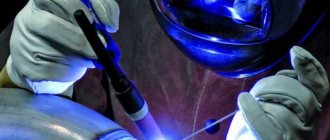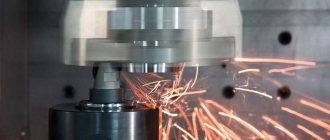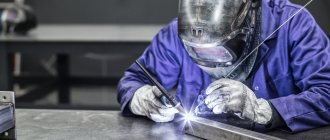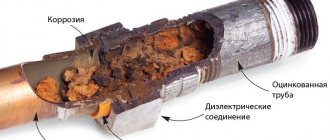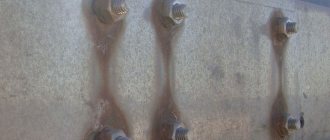Iron is one of the most common elements in the earth's crust. Currently, hundreds of tons of iron ore are extracted from its depths every minute. Such impressive production volumes have reduced the price of smelted structural steel grades. They are used in industry, mechanical engineering, construction and even in everyday life. But they have one important drawback, which greatly limits the service life of metal structures. This is susceptibility to oxidation.
The surface of the steel part comes into contact with oxygen and the chemical process of formation of oxides (rust) starts. Further spread of rust into the part depends on the conditions of two-way diffusion. The first factor is the ability of oxygen atoms to penetrate under the oxide film to the inner layers of the metal, the second is the intensity of the movement of iron ions from the inner layers to the surface. The oxidation process itself can be slightly slowed down using heat treatment, paint and varnish coatings, and metallization of surfaces with inert elements, but it cannot be stopped. This can only be done by changing the chemical composition of the steel.
Types of welding work that our company is ready to offer
Argon welding - this type of work is used when a permanent weld is required; it combines the use of an electric arc and gas; Gas welding - the method is characterized by long-term heating of metals, the power is convenient to control, gas welding uses flammable gas and oxygen; Semi-automatic welding - the principle of semi-automatic welding is that shielding gas is supplied to the welding zone with a moving electrode wire; Manual arc welding (MMA, RD, RDS) - in this case, the welded joint is formed using an electric arc, which is formed between the electrode and the metal; Assembly and welding work - assembly of products before welding according to templates, drawings or initial model; Welding and repair work - necessary for deformation of structures and metal parts, helps to avoid major accidents; Welding and plumbing work is a complex type of work that includes the manufacture and installation of products; Spot (resistance) welding - the essence of the method is to connect metal parts with two electrodes.
Offer from the workshop on Alekseevskaya
Qualified workshop specialists perform welding work of any complexity according to customer drawings:
- Welding of pipes (elements of water and gas pipelines, engineering communications of residential buildings and industrial workshops, collectors, piping of units).
- Assembly of technological devices, storage tanks, settling tanks, mixers for the chemical and food industries.
- Welding of building metal structures, reinforcement and embedded elements for reinforced concrete products.
- Repair and assembly of welded household products, kitchen appliances, sanitary containers.
The work is carried out using the argon-arc welding method, which ensures an even, durable and aesthetic seam.
Stages of production of structures using welding
Studying drawings - we are ready to work on your sketches or start developing them from scratch; Material preparation - we work only with high-quality steel: carbon and alloy; Welding work is the process of joining parts itself; Testing is testing a structure or product for strength.
What electrodes should you use to cook stainless steel?
For welding stainless steel, special electrodes are used, which are characterized by low thermal expansion and a high elasticity coefficient. Also, stainless steel electrodes must have high thermal conductivity and wear resistance, and have increased resistance to thermal creep.
For welding stainless steel, OK 67.60 electrodes from the well-known company ESAB have proven themselves well. You can also use ESAB OK67.60 for welding with a rutile-acid coating, which are characterized by easy ignition and confidently hold the welding arc.
Of the domestic brands of stainless steel electrodes, it is best to use TsL-11 or OZL-8 electrodes. They are not so expensive in price, however, they require a certain skill from the welder. Often these electrodes stick to the metal and go out during the welding process of stainless steel.
Welding of metal structures
Welding of metal structures allows you to firmly connect any number of elements of different configurations. Metal parts are welded together using two energy sources - electricity or gas. The master can carry out both types of welding (gas and electric arc) manually and using automatic or semi-automatic control of energy flows. In manual welding, the seams on products are formed by hand during the work process - therefore, only experienced craftsmen are allowed to perform welding work.
Advantages of welding stainless steel with argon
Repair of various stainless steel products is carried out using an argon arc. This process brings with it a number of advantages.
- The seam is of high quality, reliable and durable, and all thanks to the complete absence of pores.
- The products are externally aesthetic due to the characteristics of the material and careful welding.
- Thanks to the use of argon, it becomes possible to repair metals with different compositions: bronze, nickel, carbon steel, titanium, brass, and so on.
- This type of welding can be used even when working with metal sheets of small thickness.
- Argon is used to protect products from high temperatures.
- The process takes place without the use of filler wire.
- Argon is supplied manually or automatically.
- You can observe any stage of welding.
- There is no splashing of metal particles.
- Any plane is suitable for argon welding.
- There will be no slag in the seam.
- Speed of the process.
- The need for minimal technical equipment.
The only downsides are the difficulty of performing the work and the need to purchase high-quality, expensive equipment. It is also important to be able to properly configure the device so that welding is fast and efficient.
Features of welding non-standard products
Non-standard metal structures are products that are manufactured individually according to a pre-agreed sketch. These can be shelving for warehouses, suspended ceiling elements of unusual design, advertising billboards, frames and decorative elements for stairs, ramps, podiums, metal products for landscape design and interior design. The welding process is part of the formation and processing of products of this type. But before making complex connections between elements by welding, the master and the customer first prepare a sketch of the future structure and make accurate calculations. And then, strictly according to the drawing, specialists weld and connect the elements of the product. The peculiarity of this process is that the work is performed not only mechanically, but also creatively.
Dimensions and standards
Seamless hot-rolled mirror pipes are produced from Ø 57 mm to Ø 325 mm, wall thickness varies from 3.5–32 mm. Cold-formed seamless mirror pipes are produced from Ø 5 mm to Ø 89 mm and are divided into the following types:
- especially thin-walled – 0.2–0.6 mm;
- thin-walled – 0.7–2.0 mm;
- thick-walled – up to 6 mm;
- especially thick-walled – up to 12 mm
Welded stainless steel is available in diameters ranging from 8–102 mm with a wall thickness of up to 4 mm. The length of stainless steel pipes varies from 1 to 11.5 m. Mirror stainless steel is divided into 2 classes based on its cross-section - profile (square, rectangular) and round.
Welding work for the repair of special equipment
Special equipment includes various vehicles used in construction and road work - cranes, excavators, bulldozers, loaders, etc. Initially, this equipment is made to be durable and wear-resistant, but due to active use in difficult conditions, even it fails. Among other repair activities, special equipment is repaired by welding. They are needed if there are kinks or cracks in the equipment, if it is necessary to correct a defect in the welds, or when it is necessary to weld a new element to the structure. Welding work can be electric or gas. The place of work can also be different - it is either welding at the place where the equipment is working, or working with certain of its elements in special welding workshops.
Carrying out marking
First, mark the steps of the future staircase. It is in these places that the racks and handrails are attached. The best option for many masters is to determine the location of the first and last steps. And then stretch the cord between two points. Stands are placed at equal distances along the stretched cord.
Important! The sole should be in the central part of the step.
In order to make racks, railings and crossbars from separate pieces of pipe, you need to mark markers for future cutting. At the initial stage, the height of the balusters is measured. It is necessary to determine the dimensions of the cradle and adjustable tips. Appropriate marks must be left on the surface of the pipe. The angle should be exactly 90 degrees.
Welding of reinforced frames
Reinforcing cages are used in construction and are part of the foundation. Therefore, they should be the most durable element. Welding is often used as a method for manufacturing frames based on reinforcement. The welded connection in this case is considered the most reliable, since the product turns out to be practically indestructible - the welding seams of the reinforcement frame are difficult to break even with the help of special equipment. To weld frame elements, several different types of welding are used - electric arc, spot, butt welding, longitudinal seams and pool welding. Specialists can use either one of these methods, depending on the situation, or use a combination of several to create a particularly strong and reliable structure.
Methods for polishing stainless steel
In factory conditions, complex industrial methods and technologies are used that are not available at home. The same polishing methods are used for welded and seamless pipes:
- Abrasive.
In this case, polishing steel to a mirror finish is carried out dry or with the addition of water in several stages - rough grinding at the manufacturing stage, improved using an abrasive with a reduced grain size and final polishing with a fine sanding belt or felt.
- Electrochemical.
Here the pipe is completely immersed in acid, an electrode is installed around it or inside it, to which voltage is applied. Under the influence of a chemical reaction, the inner and outer surfaces of the pipe are leveled to perfect smoothness.
- LiveJournal
- Blogger
Abrasive paste for polishing stainless steel
Pipeline welding
The work of welding pipeline elements is scrupulous, so only an experienced craftsman performs it. The strength, reliability and longevity of the metal structure will depend on the quality of welding. Before welding, it is necessary to prepare metal pipes. Markings are applied to the metal products to thoroughly fit them to each other. Then the chamfer is removed (2-3 mm). Immediately before starting welding, the surfaces of the pipes must be joined, leaving a small gap between them - for the future seam. During welding, the master makes sure that no pores are formed and that all elements are tightly welded to each other without shifting. Finally, the surfaces of the metal pipes are cleaned of pores and cleaned until smooth and shiny. In a perfectly welded pipeline there is not a hint of roughness, grooves, or other defects.
What equipment to use when welding?
For high-quality welding, it is important not to skimp and purchase reliable and convenient equipment. This includes a standard inverter, an oscillator and an argon cylinder. Also important is the torch, wires and hoses. The consumables are filler wire and argon.
It is not enough to simply buy these devices; it is important to be experienced in this matter and understand all the technological processes of the issue. For example, selecting a lens for a torch, installing an electrode, choosing the diameter of the rod, calculating the thickness of parts, choosing the current strength and other characteristics are important to know.
If you want to get a durable and quick repair of stainless steel structures, contact our workshop. We have technical equipment in accordance with GOST requirements. The team consists of the best workers who responsibly carry out any task, have extensive experience and the necessary qualifications. We guarantee the reliability and durability of the resulting seam, as well as its evenness and attractive appearance to all clients!

